Biowaste Valorisation and Its Possible Perspectives Within Sustainable Food Chain Development
Abstract
1. Introduction
1.1. Background Premises
1.2. Waste Amount Prediction Calculation
2. Economic, Health-Related, and Ecological Benefits
2.1. Cost-Effectiveness-Based Advantages of Agro-Waste Valorisation
2.2. Ecosystems-Based Benefits of Agro-Waste Valorisation
2.3. Health Benefits of Biowaste Valorisation
3. Nanofiber Applications in the Food Industry
Food Preservation and Shelf Life Extension
4. Discussion
5. Limitations, Challenges, and Future Perspectives
6. Conclusions
Author Contributions
Funding
Data Availability Statement
Acknowledgments
Conflicts of Interest
References
- Singh, R.B.; Srinagesh, B.; Anand, S. Urban Health Risk and Resilience in Asian Cities; Springer: Berlin/Heidelberg, Germany, 2020. [Google Scholar] [CrossRef]
- Phiri, R.; Mavinkere Rangappa, S.; Siengchin, S.; Oladijo, O.P.; Dhakal, H.N. Development of sustainable biopolymer-based composites for lightweight applications from agricultural waste biomass: A review. Adv. Ind. Eng. Polym. Res. 2023, 6, 436–450. [Google Scholar] [CrossRef]
- Lou, J.; Rezaee Babadi, M.; Otadi, M.; Tarahomi, M.; Van Le, Q.; Ali Khonakdar, H.; Li, C. Agricultural waste valorization towards (nano)catalysts for the production of chemicals and materials. Fuel 2023, 351, 128935. [Google Scholar] [CrossRef]
- El-Ramady, H.; Brevik, E.C.; Bayoumi, Y.; Shalaby, T.A.; El-Mahrouk, M.E.; Taha, N.; Elbasiouny, H.; Elbehiry, F.; Amer, M.; Abdalla, N.; et al. An Overview of Agro-Waste Management in Light of the Water-Energy-Waste Nexus. Sustainability 2022, 14, 15717. [Google Scholar] [CrossRef]
- Bonciu, E.; Păunescu, R.A.; Roșculete, E.; Păunescu, G. Waste management in agriculture. Sci. Pap. Ser. Manag. Econ. Eng. Agric. Rural Dev. 2021, 21, 219–228. [Google Scholar]
- Zhao, J.; Yu, L.; Ma, H.; Zhou, F.; Yang, K.; Wu, G. Corn stalk-based activated carbon synthesized by a novel activation method for high-performance adsorption of hexavalent chromium in aqueous solutions. J. Colloid Interface Sci. 2020, 578, 650–659. [Google Scholar] [CrossRef]
- Mishra, B.; Mohanta, Y.K.; Reddy, C.N.; Reddy, S.D.M.; Mandal, S.K.; Yadavalli, R.; Sarma, H. Valorization of agro-industrial biowaste to biomaterials: An innovative circular bioeconomy approach. Circ. Econ. 2023, 2, 100050. [Google Scholar] [CrossRef]
- Islam, N.F.; Gogoi, B.; Saikia, R.; Yousaf, B.; Narayan, M.; Sarma, H. Encouraging circular economy and sustainable environmental practices by addressing waste management and biomass energy production. Reg. Sustain. 2024, 5, 100174. [Google Scholar] [CrossRef]
- Eurostat-European Commission. Available online: https://ec.europa.eu/eurostat/databrowser/view/env_wasgen/default/table?lang=en (accessed on 11 July 2023).
- Available online: https://eur-lex.europa.eu/legal-content/EN/TXT/PDF/?uri=CELEX:02000D0532-20150601 (accessed on 14 May 2025).
- Sharma, P.; Bano, A.; Verma, K.; Yadav, M.; Varjani, S.; Singh, S.P.; Tong, Y.W. Food waste digestate as biofertilizer and their direct applications in agriculture. Bioresour. Technol. Rep. 2023, 23, 101515. [Google Scholar] [CrossRef]
- Awogbemi, O.; Von Kallon, D.V. Pretreatment techniques for agricultural waste. Case Stud. Chem. Environ. Eng. 2022, 6, 100229. [Google Scholar] [CrossRef]
- Awogbemi, O.; Von Kallon, D.V. Valorization of agricultural wastes for biofuel applications. Heliyon 2022, 8, e11117. [Google Scholar] [CrossRef]
- Caldeira, C.; De Laurentiis, V.; Ghose, A.; Corrado, S.; Sala, S. Grown and thrown: Exploring approaches to estimate food waste in EU countries. Resour. Conserv. Recycl. 2021, 168, 105426. [Google Scholar] [CrossRef]
- Phonthanukitithaworn, C.; Maitree, N.; Naruetharadhol, P. Eco-innovation policies for food waste management: A European Union-ASEAN comparison. J. Open Innov. Technol. Mark. Complex. 2024, 10, 100295. [Google Scholar] [CrossRef]
- Scherhaufer, S.; Moates, G.; Hartikainen, H.; Waldron, K.; Obersteiner, G. Environmental impacts of food waste in Europe. Waste Manag. 2018, 77, 98–113. [Google Scholar] [CrossRef] [PubMed]
- Okolie, J.A.; Jimoh, T.; Akande, O.; Okoye, P.U.; Ogbaga, C.C.; Adeleke, A.A.; Ikubanni, P.P.; Güleç, F.; Amenaghawon, A.N. Pathways for the valorization of animal and human waste to biofuels, sustainable materials, and value-added chemicals. Environments 2023, 10, 46. [Google Scholar] [CrossRef]
- Shukla, I. Potential of renewable agricultural wastes in the smart and sustainable steelmaking process. J. Clean. Prod. 2022, 370, 133422. [Google Scholar] [CrossRef]
- Alyami, M.; Hakeem, I.Y.; Amin, M.; Zeyad, A.M.; Tayeh, B.A.; Agwa, I.S. Effect of agricultural olive, rice husk and sugarcane leaf waste ashes on sustainable ultra-high-performance concrete. J. Build. Eng. 2023, 72, 106689. [Google Scholar] [CrossRef]
- Fareed, A.; Zaidi, S.B.A.; Ahmad, N.; Hafeez, I.; Ali, A.; Ahmad, M.F. Use of agricultural waste ashes in asphalt binder and mixture: A sustainable solution to waste management. Constr. Build. Mater. 2020, 259, 120575. [Google Scholar] [CrossRef]
- Amalina, F.; Abd Razak, A.S.; Krishnan, S.; Zularisam, A.; Nasrullah, M. Dyes removal from textile wastewater by agricultural waste as an absorbent—A review. Clean. Waste Syst. 2022, 3, 100051. [Google Scholar] [CrossRef]
- Hussain, O.A.; Hathout, A.S.; Abdel-Mobdy, Y.E.; Rashed, M.; Rahim, E.A.; Fouzy, A. Preparation and characterization of activated carbon from agricultural wastes and their ability to remove chlorpyrifos from water. Toxicol. Rep. 2023, 10, 146–154. [Google Scholar] [CrossRef]
- Dey, T.; Bhattacharjee, T.; Nag, P.; Ritika; Ghati, A.; Kuila, A. Valorization of agro-waste into value added products for sustainable development. Bioresour. Technol. Rep. 2021, 16, 100834. [Google Scholar] [CrossRef]
- Ufitikirezi, J.d.D.M.; Filip, M.; Ghorbani, M.; Zoubek, T.; Olšan, P.; Bumbálek, R.; Strob, M.; Bartoš, P.; Umurungi, S.N.; Murindangabo, Y.T.; et al. Agricultural Waste Valorization: Exploring Environmentally Friendly Approaches to Bioenergy Conversion. Sustainability 2024, 16, 3617. [Google Scholar] [CrossRef]
- Bala, S.; Garg, D.; Sridhar, K.; Inbaraj, B.S.; Singh, R.; Kamma, S.; Tripathi, M.; Sharma, M. Transformation of agro-waste into value-added bioproducts and bioactive compounds: Micro/nano formulations and application in the agri-food-pharma sector. Bioengineering 2023, 10, 152. [Google Scholar] [CrossRef] [PubMed]
- Capanoglu, E.; Nemli, E.; Tomas-Barberan, F. Novel approaches in the valorization of agricultural wastes and their applications. J. Agric. Food Chem. 2022, 70, 6787–6804. [Google Scholar] [CrossRef]
- Ferreira, D.C.M.; dos Santos, P.N.; Santos, F.H.; Molina, G.; Pelissari, F.M. Sustainability approaches for agrowaste solution: Biodegradable packaging and microbial polysaccharides bio-production. Sci. Total Environ. 2023, 886, 163922. [Google Scholar] [CrossRef] [PubMed]
- Yang, W.; Zhang, X.; Lin, K.; Chen, Y.; Cheng, B.; Pan, P.; Niu, S.; Huang, L.; Li, J.; Chen, L. High-strength lignocellulosic material from agro-waste. Ind. Crops Prod. 2024, 220, 119204. [Google Scholar] [CrossRef]
- Lounis, F.M.; Benhacine, F.; Hadj-Hamou, A.S. Improving water barrier properties of starch based bioplastics by lignocellulosic biomass addition: Synthesis, characterization and antibacterial properties. Int. J. Biol. Macromol. 2024, 283, 137823. [Google Scholar] [CrossRef]
- Abe, M.M.; Portinho, J.L.; Gonçalves, M.d.M.C.; Sanvezzo, P.B.; Freitas, C.d.; de Souza, J.F.; Carneiro, R.; Ferragut, C.; Costa, M.L.; Aouada, M.R.d.M.; et al. Development of polysaccharide bioplastic: Analysis of thermo-mechanical properties and different environmental implications. J. Clean. Prod. 2024, 469, 143163. [Google Scholar] [CrossRef]
- Pongsuwan, C.; Boonsuk, P.; Sermwittayawong, D.; Aiemcharoen, P.; Mayakun, J.; Kaewtatip, K. Banana inflorescence waste fiber: An effective filler for starch-based bioplastics. Ind. Crops Prod. 2022, 180, 114731. [Google Scholar] [CrossRef]
- Xu, J.; Sagnelli, D.; Faisal, M.; Perzon, A.; Taresco, V.; Mais, M.; Giosafatto, C.V.L.; Hebelstrup, K.H.; Ulvskov, P.; Jørgensen, B.; et al. Amylose/cellulose nanofiber composites for all-natural, fully biodegradable and flexible bioplastics. Carbohydr. Polym. 2021, 253, 117277. [Google Scholar] [CrossRef]
- Rahman, M.M.; Hossain, M.I.; Hassan, M.M.; Ghos, B.C.; Rahman, M.S.; Gafur, M.A.; Alam, M.A.; Zuhanee, M.K.A. Cellulose nanocrystal (CNC) from okra plant (Abelmoschus esculentus L.) stalks as a reinforcement in bionanocomposite fabrication: Extraction, processing, and characterization study. Carbohydr. Polym. Technol. Appl. 2024, 8, 100581. [Google Scholar] [CrossRef]
- Reshmy, R.; Madhavan, A.; Philip, E.; Paul, S.A.; Sindhu, R.; Binod, P.; Pugazhendhi, A.; Sirohi, R.; Pandey, A. Sugarcane bagasse derived nanocellulose reinforced with frankincense (Boswellia serrata): Physicochemical properties, biodegradability and antimicrobial effect for controlling microbial growth for food packaging application. Environ. Technol. Innov. 2021, 21, 101335. [Google Scholar] [CrossRef]
- Li, Z.; Yang, J.; Loh, X.J. Polyhydroxyalkanoates: Opening doors for a sustainable future. NPG Asia Mater. 2016, 8, e265. [Google Scholar] [CrossRef]
- Adebayo Oyewole, O.; Usman Abdulmalik, S.; Onozasi Abubakar, A.; Ishaku Chimbekujwo, K.; Dorcas Obafemi, Y.; Oyegbile, B.; Peter Abioye, O.; David Adeniyi, O.; Chidi Egwim, E. Production of polyhydroxyalkanoate (pha) by pseudomonas aeruginosa (ol405443) using agrowastes as carbon source. Clean. Mater. 2024, 11, 100217. [Google Scholar] [CrossRef]
- Elegbede, J.A.; Ajayi, V.A.; Lateef, A. Microbial valorization of corncob: Novel route for biotechnological products for sustainable bioeconomy. Environ. Technol. Innov. 2021, 24, 102073. [Google Scholar] [CrossRef]
- Topuz, F.; Uyar, T. Electrospinning of sustainable polymers from biomass for active food packaging. Sustain. Food Technol. 2024, 2, 1266–1296. [Google Scholar] [CrossRef]
- Amir, M.; Rizvi, S.F.; Asif, M.; Ahmad, A.; Alshammari, M.B.; Gupta, A.; Zaheer, M.R.; Roohi, R. Polyhydroxybutyrate (PHB) bioplastic characterization from the isolate Pseudomonas stutzeri PSB1 synthesized using potato peel feedstock to combat solid waste management. Biocatal. Agric. Biotechnol. 2024, 57, 103097. [Google Scholar] [CrossRef]
- Babu, A.; Kumar, A.R.; Amrutha, N.R.; Madhurya, S.; Punil Kumar, H.N.; Reddy, J.P.; Murthy, P.S.K.; Varaprasad, K. Utilizing foxtail millet husk waste for sustainable new bioplastic composites with enhanced thermal stability and biodegradability. Int. J. Biol. Macromol. 2024, 282, 137283. [Google Scholar] [CrossRef]
- Kee, S.H.; Ganeson, K.; Rashid, N.F.M.; Yatim, A.F.M.; Vigneswari, S.; Amirul, A.-A.A.; Ramakrishna, S.; Bhubalan, K. A review on biorefining of palm oil and sugar cane agro-industrial residues by bacteria into commercially viable bioplastics and biosurfactants. Fuel 2022, 321, 124039. [Google Scholar] [CrossRef]
- Famiglietti, M.; Mirpoor, S.F.; Caporale, A.G.; Cappelli, C.; Tarallo, O.; Mariniello, L. Hydrocolloid-based bioplastics: Degradation in characterized soils. Int. J. Biol. Macromol. 2025, 284, 137988. [Google Scholar] [CrossRef]
- Alonso-González, M.; Felix, M.; Romero, A.; Sergi, C.; Bavasso, I.; Sarasini, F. Lab-scale biocomposite manufacturing: Exploring rice bran-based bioplastics reinforced with natural fillers through extrusion and injection molding. Resour. Conserv. Recycl. 2025, 212, 107990. [Google Scholar] [CrossRef]
- Abdullah, J.A.A.; Perdomo, C.A.A.; Núñez, L.A.H.; Rivera-Flores, O.; Sánchez-Barahona, M.; Guerrero, A.; Romero, A. Lychee peel extract-based magnetic iron oxide nanoparticles: Sustainable synthesis, multifaceted antioxidant system, and prowess in eco-friendly food preservation. Food Bioprod. Process. 2024, 145, 148–157. [Google Scholar] [CrossRef]
- Moure Abelenda, A.; Semple, K.T.; Herbert, B.M.J.; Aggidis, G.; Aiouache, F. Valorization of agrowaste digestate via addition of wood ash, acidification, and nitrification. Environ. Technol. Innov. 2022, 28, 102632. [Google Scholar] [CrossRef]
- Kannan, M.B.; Ronan, K. Conversion of biowastes to biomaterial: An innovative waste management approach. Waste Manag. 2017, 67, 67–72. [Google Scholar] [CrossRef]
- Lim, S.-F.; Matu, S.U. Utilization of agro-wastes to produce biofertilizer. Int. J. Energy Environ. Eng. 2015, 6, 31–35. [Google Scholar] [CrossRef]
- Aguilar-Rivera, N. Economic Viability and Policy Implications of Agriculture Waste Valorization: Social and Economic Impacts, Policy Frameworks, and Regulations. In Transforming Agriculture Residues for Sustainable Development: From Waste to Wealth; Arora, J., Joshi, A., Ray, R.C., Eds.; Springer Nature: Cham, The Switzerland, 2024; pp. 393–419. [Google Scholar] [CrossRef]
- Prado-Acebo, I.; Cubero-Cardoso, J.; Lu-Chau, T.A.; Eibes, G. Integral multi-valorization of agro-industrial wastes: A review. Waste Manag. 2024, 183, 42–52. [Google Scholar] [CrossRef]
- Karić, N.; Maia, A.S.; Teodorović, A.; Atanasova, N.; Langergraber, G.; Crini, G.; Ribeiro, A.R.L.; Đolić, M. Bio-waste valorisation: Agricultural wastes as biosorbents for removal of (in)organic pollutants in wastewater treatment. Chem. Eng. J. Adv. 2022, 9, 100239. [Google Scholar] [CrossRef]
- Hiranobe, C.T.; Gomes, A.S.; Paiva, F.F.G.; Tolosa, G.R.; Paim, L.L.; Dognani, G.; Cardim, G.P.; Cardim, H.P.; dos Santos, R.J.; Cabrera, F.C. Sugarcane Bagasse: Challenges and Opportunities for Waste Recycling. Clean Technol. 2024, 6, 662–699. [Google Scholar] [CrossRef]
- Munagala, M.; Shastri, Y.; Nagarajan, S.; Ranade, V. Production of Bio-CNG from sugarcane bagasse: Commercialization potential assessment in Indian context. Ind. Crops Prod. 2022, 188, 115590. [Google Scholar] [CrossRef]
- Mahale, M.R.; Kodam, K.M. Chapter 7—The emergence of agrowaste valorization: A revolutionizing sustainability. In Sustainable Management of Agro-Food Waste; Rai, S., Bhardwaj, A.K., Colla, L.M., Eds.; Academic Press: Cambridge, MA, USA, 2025; pp. 87–104. [Google Scholar] [CrossRef]
- Popa, I.; Vasile, V.; Lambrache, S. Superior capitalization of vegetable waste and natural agro-industrial by-products by creating innovative products for construction. Socio-economic predictive analyses. Sci. Papers. Ser. E Land Reclam. Earth Obs. Surv. Environ. Eng. 2024, 13, 340–347. [Google Scholar]
- Schiebel, C.S.; Bueno, L.R.; Pargas, R.B.; de Mello Braga, L.L.V.; da Silva, K.S.; Fernandes, A.C.V.U.; dos Santos Maia, M.H.; de Oliveira, N.M.T.; Bach, C.; Maria-Ferreira, D. Exploring the biological activities and potential therapeutic applications of agro-industrial waste products through non-clinical studies: A systematic review. Sci. Total Environ. 2024, 950, 175317. [Google Scholar] [CrossRef]
- Lee, J.; Kim, M.; Jung, J.; Heo, J.W.; Lee, K.H.; Kim, S.; Son, H.; Chun, Y.; Yoo, H.Y. Valorization of persimmon calyx, an industrial biowaste, as a potential resource for antioxidant production. Environ. Technol. Innov. 2023, 30, 103038. [Google Scholar] [CrossRef]
- Bains, A.; Sridhar, K.; Singh, B.N.; Kuhad, R.C.; Chawla, P.; Sharma, M. Valorization of onion peel waste: From trash to treasure. Chemosphere 2023, 343, 140178. [Google Scholar] [CrossRef] [PubMed]
- Baiano, A. Recovery of Biomolecules from Food Wastes—A Review. Molecules 2014, 19, 14821–14842. [Google Scholar] [CrossRef]
- Arpit Singh, T.; Sharma, M.; Sharma, M.; Dutt Sharma, G.; Kumar Passari, A.; Bhasin, S. Valorization of agro-industrial residues for production of commercial biorefinery products. Fuel 2022, 322, 124284. [Google Scholar] [CrossRef]
- IEA. Average Biogas Production Yield by Tonne of Feedstock Type; IEA: Paris, France; Available online: https://www.iea.org/data-and-statistics/charts/average-biogas-production-yield-by-tonne-of-feedstock-type (accessed on 8 June 2025).
- Nazia Hossain, J.H.Z.T.M.I.M. A Review of Bioethanol Production from Plant-based Waste Biomass by Yeast Fermentation. Int. J. Technol. 2017, 8, 291–319. [Google Scholar] [CrossRef]
- Yaashikaa, P.R.; Kumar, P.S.; Varjani, S. Valorization of agro-industrial wastes for biorefinery process and circular bioeconomy: A critical review. Bioresour. Technol. Rep. 2022, 343, 126126. [Google Scholar] [CrossRef]
- Bentivoglio, D.; Chiaraluce, G.; Finco, A. Economic assessment for vegetable waste valorization through the biogas-biomethane chain in Italy with a circular economy approach. Front. Sustain. Food Syst. 2022, 6, 1035357. [Google Scholar] [CrossRef]
- Donner, M.; Gohier, R.; de Vries, H. A new circular business model typology for creating value from agro-waste. Sci. Total Environ. 2020, 716, 137065. [Google Scholar] [CrossRef]
- Baseri, S. Environmentally sound recycling of agricultural waste: A sustainable approach to develop bio-functional art textile. J. Environ. Manag. 2024, 366, 121758. [Google Scholar] [CrossRef]
- Jalil, M.A.; Repon, M.R.; Jurkonienė, S.; Haji, A.; Hussain, S.Z.; Shukhratov, S. Valorization of pineapple leaves: Effective conversion of agro waste to textile materials. Energy Sci. Eng. 2024, 12, 2426–2434. [Google Scholar] [CrossRef]
- Ragini, Y.P.; Karishma, S.; Kamalesh, R.; Saravanan, A.; TajSabreen, B.; Eswaar, D.K. Sustainable biorefinery approaches in the valorization of agro-food industrial residues for biofuel production: Economic and future perspectives. Sustain. Energy Technol. Assess. 2025, 75, 104239. [Google Scholar] [CrossRef]
- Hogg, D. Costs for Municipal Waste Management in the EU, Final Report to Directorate General Environment; Eunomia Research & Consulting Ltd.: Brussels, Belgium, 2001; Available online: https://ec.europa.eu/environment/pdf/waste/studies/euwastemanagement_annexes.pdf (accessed on 9 June 2025).
- Roy, P.; Mohanty, A.K.; Dick, P.; Misra, M. A Review on the Challenges and Choices for Food Waste Valorization: Environmental and Economic Impacts. ACS Environ. Au 2023, 3, 58–75. [Google Scholar] [CrossRef]
- Ashraf, A.I.; Mohareb, E.; Vahdati, M. Evaluation of life cycle cost for the comparison of decentralized waste to composting and landfilling of municipal solid waste. Discov. Sustain. 2024, 5, 202. [Google Scholar] [CrossRef]
- Hogg, D.; Favoino, E.; Nielsen, N.; Thompson, J.; Wood, K.; Penschke, A.; Economides, D.; Papageorgiou, S. Economic Analysis of Options for Managing Biodegradable Municipal Waste; Final report to the European Commission; European Commission: Bristol, UK, 2002. [Google Scholar]
- Badagliacca, G.; Testa, G.; La Malfa, S.G.; Cafaro, V.; Lo Presti, E.; Monti, M. Organic Fertilizers and Bio-Waste for Sustainable Soil Management to Support Crops and Control Greenhouse Gas Emissions in Mediterranean Agroecosystems: A Review. Horticulturae 2024, 10, 427. [Google Scholar] [CrossRef]
- He, X.; Wang, Y.; Zhang, Y.; Wang, C.; Yu, J.; Ohtake, H.; Zhang, T. The potential for livestock manure valorization and phosphorus recovery by hydrothermal technology—A critical review. Mater. Sci. Energy Technol. 2023, 6, 94–104. [Google Scholar] [CrossRef]
- Koul, B.; Yakoob, M.; Shah, M.P. Agricultural waste management strategies for environmental sustainability. Environ. Res. 2022, 206, 112285. [Google Scholar] [CrossRef] [PubMed]
- Mutmainna, I.; Gareso, P.L.; Suryani, S.; Tahir, D. Can agriculture and food waste be a solution to reduce environmental impact of plastic pollution? zero-waste approach for sustainable clean environment. Bioresour. Technol. 2025, 420, 132130. [Google Scholar] [CrossRef]
- Sholokhova, A.; Varžinskas, V.; Rutkaitė, R. Valorization of Agro-waste in Bio-based and Biodegradable Polymer Composites: A Comprehensive Review with Emphasis on Europe Perspective. Waste Biomass Valori. 2024, 16, 1537–1571. [Google Scholar] [CrossRef]
- Pattnaik, S.S.; Behera, D.; Das, N.; Dash, A.K.; Behera, A.K. Fabrication and characterization of natural fiber reinforced cowpea resin-based green composites: An approach towards agro-waste valorization. RSC Adv. 2024, 14, 25728–25739. [Google Scholar] [CrossRef]
- Ashraf, H.; Karahan, B.D. Biowaste valorization into valuable nanomaterials: Synthesis of green carbon nanodots and anode material for lithium-ion batteries from watermelon seeds. Mater. Res. Bull. 2024, 169, 112492. [Google Scholar] [CrossRef]
- Afolalu, S.; Salawu, E.; Ogedengbe, T.; Joseph, O.; Okwilagwe, O.; Emetere, M.; Yusuf, O.; Noiki, A.; Akinlabi, S. Bio-agro waste valorization and its sustainability in the industry: A review. IOP Conf. Ser. Mater. Sci. Eng. 2021, 1107, 012140. [Google Scholar] [CrossRef]
- Rao, P.; Rathod, V. Valorization of food and agricultural waste: A step towards greener future. Chem. Rec. 2019, 19, 1858–1871. [Google Scholar] [CrossRef] [PubMed]
- Falade, A.O. Valorization of agricultural wastes for production of biocatalysts of environmental significance: Towards a sustainable environment. Environ. Sustain. 2021, 4, 317–328. [Google Scholar] [CrossRef]
- Steiger, B.G.K.; Zhou, Z.; Anisimov, Y.A.; Evitts, R.W.; Wilson, L.D. Valorization of agro-waste biomass as composite adsorbents for sustainable wastewater treatment. Ind. Crops Prod. 2023, 191, 115913. [Google Scholar] [CrossRef]
- El-Qelish, M.; Maged, A.; Elwakeel, K.Z.; Bhatnagar, A.; Elgarahy, A.M. Dual valorization of coastal biowastes for tetracycline remediation and biomethane production: A composite assisted anaerobic digestion. J. Hazard. Mater. 2024, 465, 133143. [Google Scholar] [CrossRef]
- Mignardi, S.; Tocci, E.; Medeghini, L. Clam shell waste recycling and valorization for sustainable Hg remediation. Heliyon 2024, 10, e35375. [Google Scholar] [CrossRef]
- Lago, A.; Silva, B.; Tavares, T. Biowaste valorization on pharmaceuticals and pesticides abatement in aqueous environments. Sustain. Mater. Technol. 2024, 39, e00792. [Google Scholar] [CrossRef]
- Nichita, A.; Popa, M.E. The valorization of plant and animal by-products for food sustainability. Sci. Papers. Ser. D Anim. Sci. 2024, 67, 524. [Google Scholar]
- Puglia, D.; Pezzolla, D.; Gigliotti, G.; Torre, L.; Bartucca, M.L.; Del Buono, D. The Opportunity of Valorizing Agricultural Waste, Through Its Conversion into Biostimulants, Biofertilizers, and Biopolymers. Sustainability 2021, 13, 2710. [Google Scholar] [CrossRef]
- Srivastava, R.K.; Shetti, N.P.; Reddy, K.R.; Nadagouda, M.N.; Badawi, M.; Bonilla-Petriciolet, A.; Aminabhavi, T.M. Valorization of biowastes for clean energy production, environmental depollution and soil fertility. J. Environ. Manag. 2023, 332, 117410. [Google Scholar] [CrossRef]
- Zayed, A.; Badawy, M.T.; Farag, M.A. Valorization and extraction optimization of Citrus seeds for food and functional food applications. Food Chem. 2021, 355, 129609. [Google Scholar] [CrossRef] [PubMed]
- Bisht, B.; Gururani, P.; Aman, J.; Vlaskin, M.S.; Anna, I.K.; Irina, A.A.; Joshi, S.; Kumar, S.; Kumar, V. A review on holistic approaches for fruits and vegetables biowastes valorization. Mater. Today Proc. 2023, 73, 54–63. [Google Scholar] [CrossRef]
- Lamine, M.; Hamdi, Z.; Zemni, H.; Rahali, F.Z.; Melki, I.; Mliki, A.; Gargouri, M. From residue to resource: The recovery of high-added values compounds through an integral green valorization of citrus residual biomass. Sustain. Chem. Pharm. 2024, 37, 101379. [Google Scholar] [CrossRef]
- El-Shamy, S.; Farag, M.A. Novel trends in extraction and optimization methods of bioactives recovery from pomegranate fruit biowastes: Valorization purposes for industrial applications. Food Chem. 2021, 365, 130465. [Google Scholar] [CrossRef]
- Zayed, A.; Farag, M.A. Valorization, extraction optimization and technology advancements of artichoke biowastes: Food and non-food applications. LWT 2020, 132, 109883. [Google Scholar] [CrossRef]
- Fraguela-Meissimilly, H.; Bastías-Montes, J.M.; Ortiz-Viedma, J.A.; Tamarit-Pino, Y.; Claret-Merino, M.; Araneda-Flores, J. Valorization of extracts from maqui (Aristotelia chilensis) and calafate (Berberis microphylla) biowaste blends by supercritical fluid and pressurized liquid extraction. J. Agric. Food Res. 2024, 15, 100950. [Google Scholar] [CrossRef]
- Azelee, N.I.W.; Dahiya, D.; Ayothiraman, S.; Noor, N.M.; Rasid, Z.I.A.; Ramli, A.N.M.; Ravindran, B.; Iwuchukwu, F.U.; Selvasembian, R. Sustainable valorization approaches on crustacean wastes for the extraction of chitin, bioactive compounds and their applications—A review. Int. J. Biol. Macromol. 2023, 253, 126492. [Google Scholar] [CrossRef]
- Uranga, J.; Etxabide, A.; Cabezudo, S.; de la Caba, K.; Guerrero, P. Valorization of marine-derived biowaste to develop chitin/fish gelatin products as bioactive carriers and moisture scavengers. Sci. Total Environ. 2020, 706, 135747. [Google Scholar] [CrossRef]
- Blasi, A.; Verardi, A.; Lopresto, C.G.; Siciliano, S.; Sangiorgio, P. Lignocellulosic Agricultural Waste Valorization to Obtain Valuable Products: An Overview. Recycling 2023, 8, 61. [Google Scholar] [CrossRef]
- Karnwal, A.; Kumar, G.; Singh, R.; Selvaraj, M.; Malik, T.; Al Tawaha, A.R.M. Natural biopolymers in edible coatings: Applications in food preservation. Food Chem. X 2025, 25, 102171. [Google Scholar] [CrossRef]
- Jafarzadeh, S.; Salehabadi, A.; Mohammadi Nafchi, A.; Oladzadabbasabadi, N.; Jafari, S.M. Cheese packaging by edible coatings and biodegradable nanocomposites; improvement in shelf life, physicochemical and sensory properties. Trends Food Sci. Technol. 2021, 116, 218–231. [Google Scholar] [CrossRef]
- Ojo, A.M.; Omotunde, O.I.; Otugboyega, J. Perspective Chapter: Functionalization of Nanofibers—Applications in Food Technology. In Advances in Nanofiber Research—Properties and Uses; Ameen, S., Akhtar, M.S., Kong, I., Eds.; IntechOpen: Rijeka, Croatia, 2024. [Google Scholar] [CrossRef]
- Joshi, M.; Aayush, K.; Sharma, K.; Bose, I.; Khan, A.A.; Atanassova, M.; Yang, T.; Murariu, O.C.; Sharma, S.; Caruso, G. Fiber and nanofiber based edible packaging for enhancing the shelf life of food: A review. Food Biosci. 2024, 59, 103970. [Google Scholar] [CrossRef]
- Kalita, P.; Bora, N.S.; Gogoi, B.; Goswami, A.; Pachuau, L.; Das, P.J.; Baishya, D.; Roy, S. Improving the hydrophobic nature of biopolymer based edible packaging film: A review. Food Chem. 2025, 479, 143793. [Google Scholar] [CrossRef]
- Payal, A.; Sandeep, G.D.S.; Bammidi, M.; Narayandas, A.; Syed, I.; Rao, M.V. Recent advances in plant protein-based edible coatings for shelf-life enhancement of perishable and high nutritive value foods—A Review. Food Packag. Shelf Life 2025, 48, 101465. [Google Scholar] [CrossRef]
- César de Albuquerque Sousa, T.; de Lima Costa, I.H.; Gandra, E.A.; Meinhart, A.D. Use of edible coatings as a new sustainable alternative to extend the shelf life of strawberries (Fragaria ananassa): A review. J. Stored Prod. Res. 2024, 108, 102375. [Google Scholar] [CrossRef]
- Souza, E.J.D.d.; Pacheco, C.d.O.; Costa, I.H.d.L.; Dias, A.R.G.; Zavareze, E.d.R. Applications of nanotechnology in essential oil protection to extend the shelf life of fruits and vegetables: A review. Food Control 2025, 170, 111044. [Google Scholar] [CrossRef]
- Mokhtaran, L.; Sabahi, S.; Noshad, M.; Noori, S.M.A. Investigating the effects of basil (Ocimum basilicum L.)c mucilage and cellulose nanofiber-based edible films with post-probiotics on fish fillet shelf life. Appl. Food Res. 2025, 5, 100704. [Google Scholar] [CrossRef]
- Wu, X.; Liu, Z.; He, S.; Liu, J.; Shao, W. Development of an edible food packaging gelatin/zein based nanofiber film for the shelf-life extension of strawberries. Food Chem. 2023, 426, 136652. [Google Scholar] [CrossRef]
- Wang, J.; Qin, M.; Wang, W.; Xia, Y.; Wu, G.; Deng, H.; Lin, Q. Konjac glucomannan/carboxylated cellulose nanofiber-based edible coating with tannic acid maintains quality and prolongs shelf-life of mango fruit. Food Chem. 2025, 478, 143750. [Google Scholar] [CrossRef]
- Sethunga, M.; Gunathilake, K.D.P.P.; Ranaweera, K.K.D.S.; Munaweera, I. Antimicrobial and antioxidative electrospun cellulose acetate-essential oils nanofibrous membranes for active food packaging to extend the shelf life of perishable fruits. Innov. Food Sci. Emerg. Technol. 2024, 97, 103802. [Google Scholar] [CrossRef]
- Wu, X.; Liu, Z.; Liu, J.; He, S.; Shao, W. Development of novel intelligent and edible dual-functional electrospun nanofiber films for shrimp preservation and freshness monitoring in real-time. Food Biosci. 2024, 61, 104828. [Google Scholar] [CrossRef]
- Gao, S.; Zhang, Y.; Wang, R.; Li, F.; Zhang, Y.; Zhu, S.; Wei, H.; Zhao, L.; Fu, Y.; Ye, F. Fabrication and characterization of betulin/hydroxypropyl-beta-cyclodextrin inclusion complex nanofibers: A potential edible antibacterial and antioxidant packaging material. Food Chem. 2025, 481, 144059. [Google Scholar] [CrossRef]
- Dayisoylu, K.S.; Akboğa, Z.; Doğan, C.; Kaya, E.; Akgul, Y.; Doğan, N.; Eticha, A.K. Rapid fabrication of micro-nanofibers from grapevine leaf extract and gelatine via electroblowing: A novel approach for edible active food packaging. Int. J. Biol. Macromol. 2023, 253, 127309. [Google Scholar] [CrossRef]
- Afsar, L.; Hassanzadazar, H.; Shojaee-Aliabadi, S.; Aminzare, M. Galbanum nanocomposite coating containing Satureja khuzestanica essential oil for prolonging shrimp (Metapenaeus affinis) shelf life at various temperatures. LWT 2025, 215, 117169. [Google Scholar] [CrossRef]
- Doğan, N.; Doğan, C.; Eticha, A.K.; Gungor, M.; Akgul, Y. Centrifugally spun micro-nanofibers based on lemon peel oil/gelatin as novel edible active food packaging: Fabrication, characterization, and application to prevent foodborne pathogens E. coli and S. aureus in cheese. Food Control 2022, 139, 109081. [Google Scholar] [CrossRef]
- Kaniyamparambil, S.H.; Salim, M.H.; Al Marzooqi, F.; Mettu, S.; Otoni, C.G.; Banat, F.; Tardy, B.L. A comprehensive study on the potential of edible coatings with polysaccharides, polyphenol, and lipids for mushroom preservation. Int. J. Biol. Macromol. 2025, 306, 141494. [Google Scholar] [CrossRef] [PubMed]
- Al-Moghazy, M.; El-sayed, H.S.; Salama, H.H.; Nada, A.A. Edible packaging coating of encapsulated thyme essential oil in liposomal chitosan emulsions to improve the shelf life of Karish cheese. Food Biosci. 2021, 43, 101230. [Google Scholar] [CrossRef]
- Liu, Y.; Xia, X.; Li, X.; Wang, F.; Huang, Y.; Zhu, B.; Feng, X.; Wang, Y. Design and characterization of edible chitooligosaccharide/fish skin gelatin nanofiber-based hydrogel with antibacterial and antioxidant characteristics. Int. J. Biol. Macromol. 2024, 262, 130033. [Google Scholar] [CrossRef]
- Mathura, S.R.; Landázuri, A.C.; Mathura, F.; Andrade Sosa, A.G.; Orejuela-Escobar, L.M. Hemicelluloses from bioresidues and their applications in the food industry—Towards an advanced bioeconomy and a sustainable global value chain of chemicals and materials. Sustain. Food Technol. 2024, 2, 1183–1205. [Google Scholar] [CrossRef]
- Palanisamy, S.; Selvaraju, G.D.; Selvakesavan, R.K.; Venkatachalam, S.; Bharathi, D.; Lee, J. Unlocking sustainable solutions: Nanocellulose innovations for enhancing the shelf life of fruits and vegetables—A comprehensive review. Int. J. Biol. Macromol. 2024, 261, 129592. [Google Scholar] [CrossRef]
- Zhang, S.; Chen, R.; Ding, C.; Gong, T.; Sun, J.J.; Li, F.; Zhang, C.; Wang, X.Y.; Guo, Y.; Zhong, T.; et al. Fabraction of edible bio-nanocomposite coatings from pectin-containing lignocellulosic nanofibers isolated from apple pomace. Int. J. Biol. Macromol. 2024, 279, 135030. [Google Scholar] [CrossRef] [PubMed]
- Pei, J.; Palanisamy, C.P.; Srinivasan, G.P.; Panagal, M.; Kumar, S.S.D.; Mironescu, M. A comprehensive review on starch-based sustainable edible films loaded with bioactive components for food packaging. Int. J. Biol. Macromol. 2024, 274, 133332. [Google Scholar] [CrossRef]
- Aggarwal, S.; Kathuria, D.; Singh, N. Edible films and coatings, its chemical crosslinking, starch-protein interaction and application in food system: A systematic review. Int. J. Biol. Macromol. 2025, 306, 141726. [Google Scholar] [CrossRef]
- De Buck, V.; Polanska, M.; Van Impe, J. Modeling Biowaste Biorefineries: A Review. Front. Sustain. Food Syst. 2020, 4, 11. [Google Scholar] [CrossRef]
- Paladino, O.; Neviani, M. Interchangeable modular design and operation of photo-bioreactors for Chlorella vulgaris cultivation towards a zero-waste biorefinery. Enzym. Microb. Technol. 2024, 173, 110371. [Google Scholar] [CrossRef]
- Li, F.; Li, G.; Lougou, B.G.; Zhou, Q.; Jiang, B.; Shuai, Y. Upcycling biowaste into advanced carbon materials via low-temperature plasma hybrid system: Applications, mechanisms, strategies and future prospects. Waste Manag. 2024, 189, 364–388. [Google Scholar] [CrossRef]
- Krzyżaniak, M.; Stolarski, M.J.; Waliszewska, B.; Szczukowski, S.; Tworkowski, J.; Załuski, D.; Śnieg, M. Willow biomass as feedstock for an integrated multi-product biorefinery. Ind. Crops Prod. 2014, 58, 230–237. [Google Scholar] [CrossRef]
- Elgarahy, A.M.; Eloffy, M.G.; Alengebawy, A.; Aboelela, D.; Hammad, A.; Elwakeel, K.Z. Biowaste valorization: Integrating circular economy principles with artificial intelligence-driven optimization for sustainable energy solutions. J. Environ. Chem. Eng. 2025, 13, 116673. [Google Scholar] [CrossRef]
- Hamza, M.; Kechaou, S.; Masmoudi, M.A.; Boujelben, R.; Sayadi, S.; Khoufi, S. Cost-effective fungal enzyme production and its role in methane, enhancement through biowaste hydrolysis. J. Environ. Chem. Eng. 2025, 13, 115847. [Google Scholar] [CrossRef]
- Seo, S.B.; Go, E.S.; Ling, J.L.J.; Lee, S.H. Techno-economic assessment of a solar-assisted biomass gasification process. Renew. Energy 2022, 193, 23–31. [Google Scholar] [CrossRef]
- Le, D.L.; Salomone, R.; Nguyen, Q.T. Circular bio-based building materials: A literature review of case studies and sustainability assessment methods. Build. Environ. 2023, 244, 110774. [Google Scholar] [CrossRef]
- Pareek, S. Addressing agricultural waste management challenges: Innovative approaches and best practices. Agric. Biol. Res. 2024, 40, 1229–1231. [Google Scholar] [CrossRef]
- Ding, Z.; Hamann, K.T.; Grundmann, P. Enhancing circular bioeconomy in Europe: Sustainable valorization of residual grassland biomass for emerging bio-based value chains. Sustain. Prod. Consum. 2024, 45, 265–280. [Google Scholar] [CrossRef]
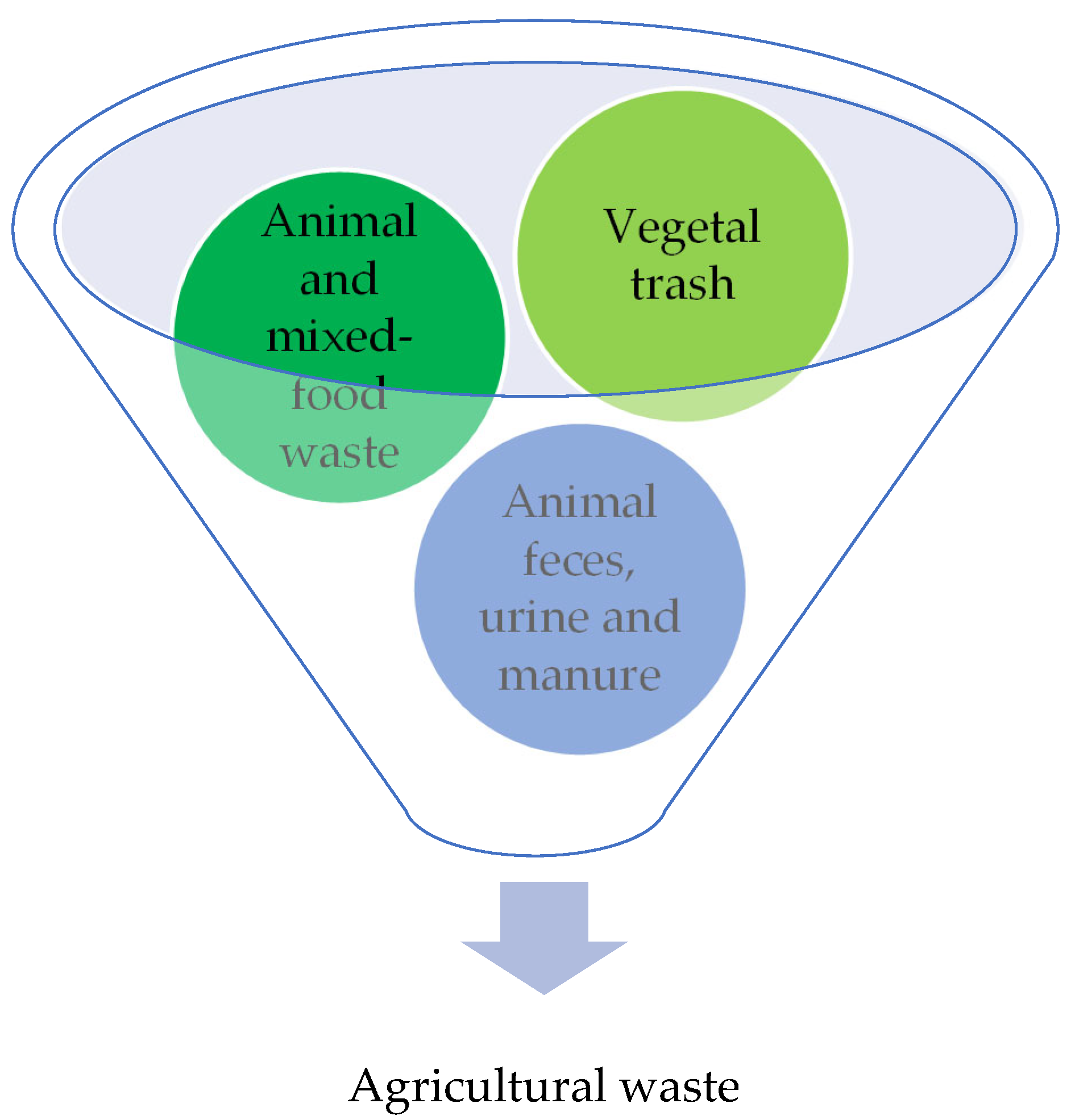
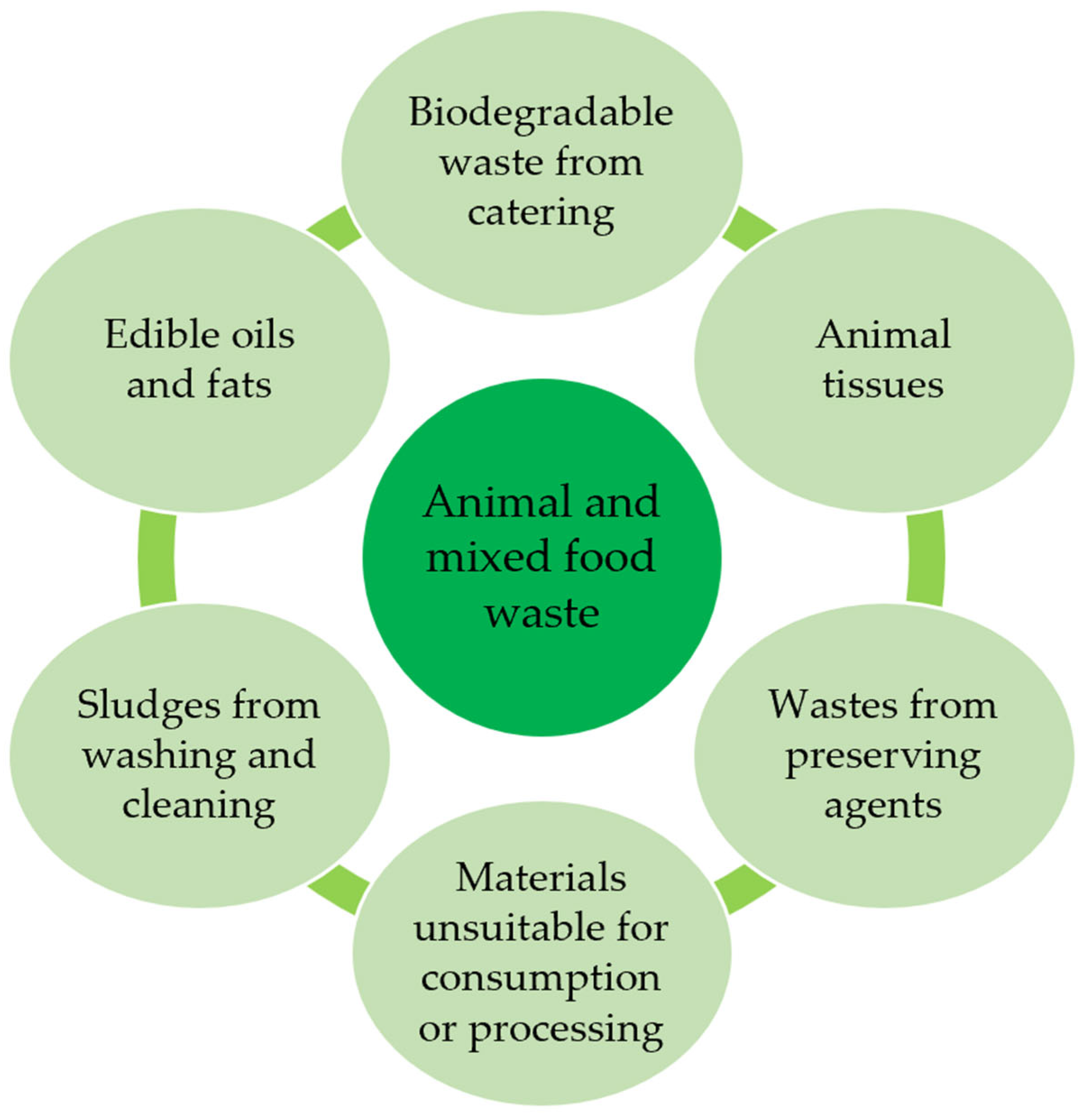
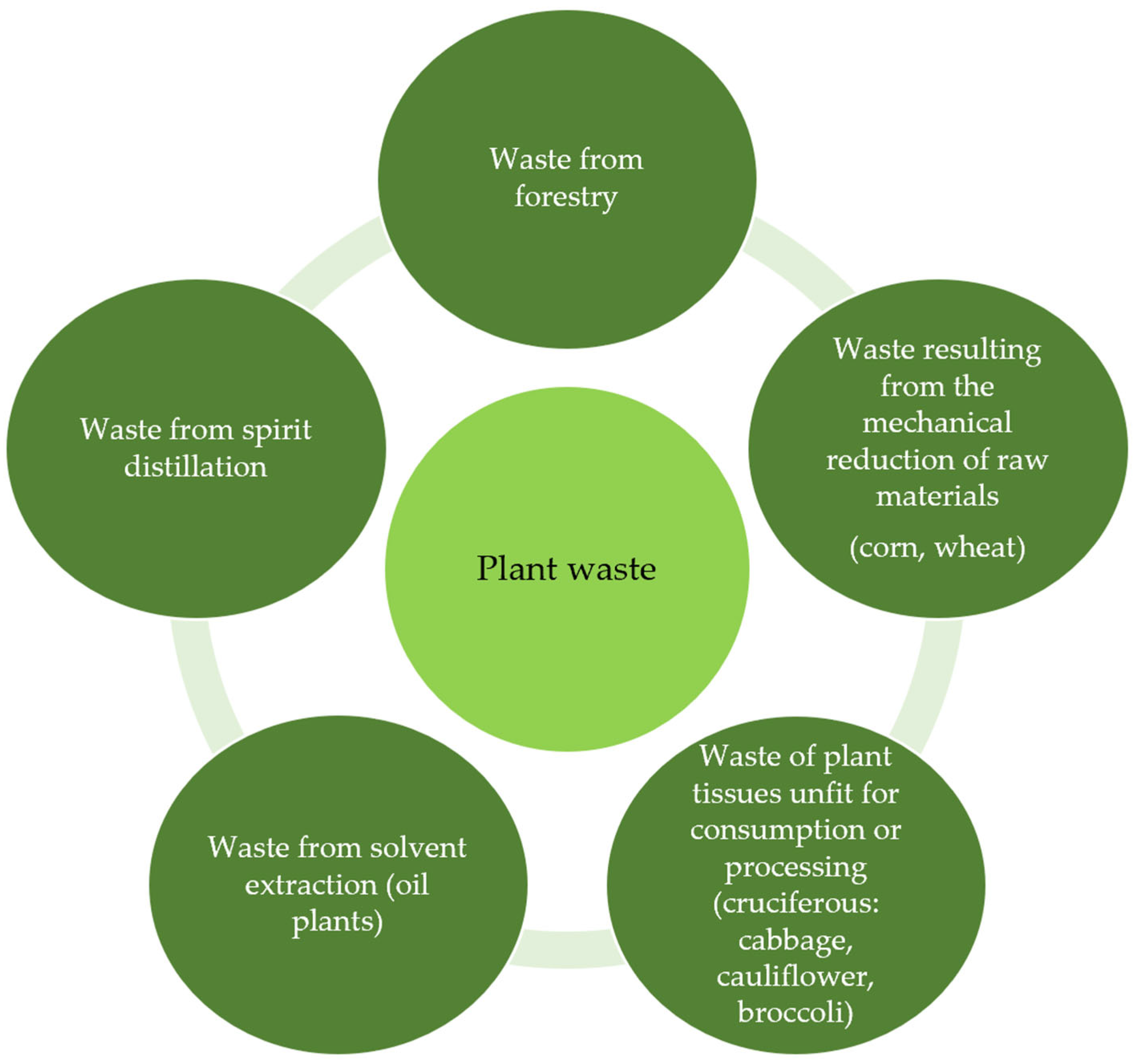
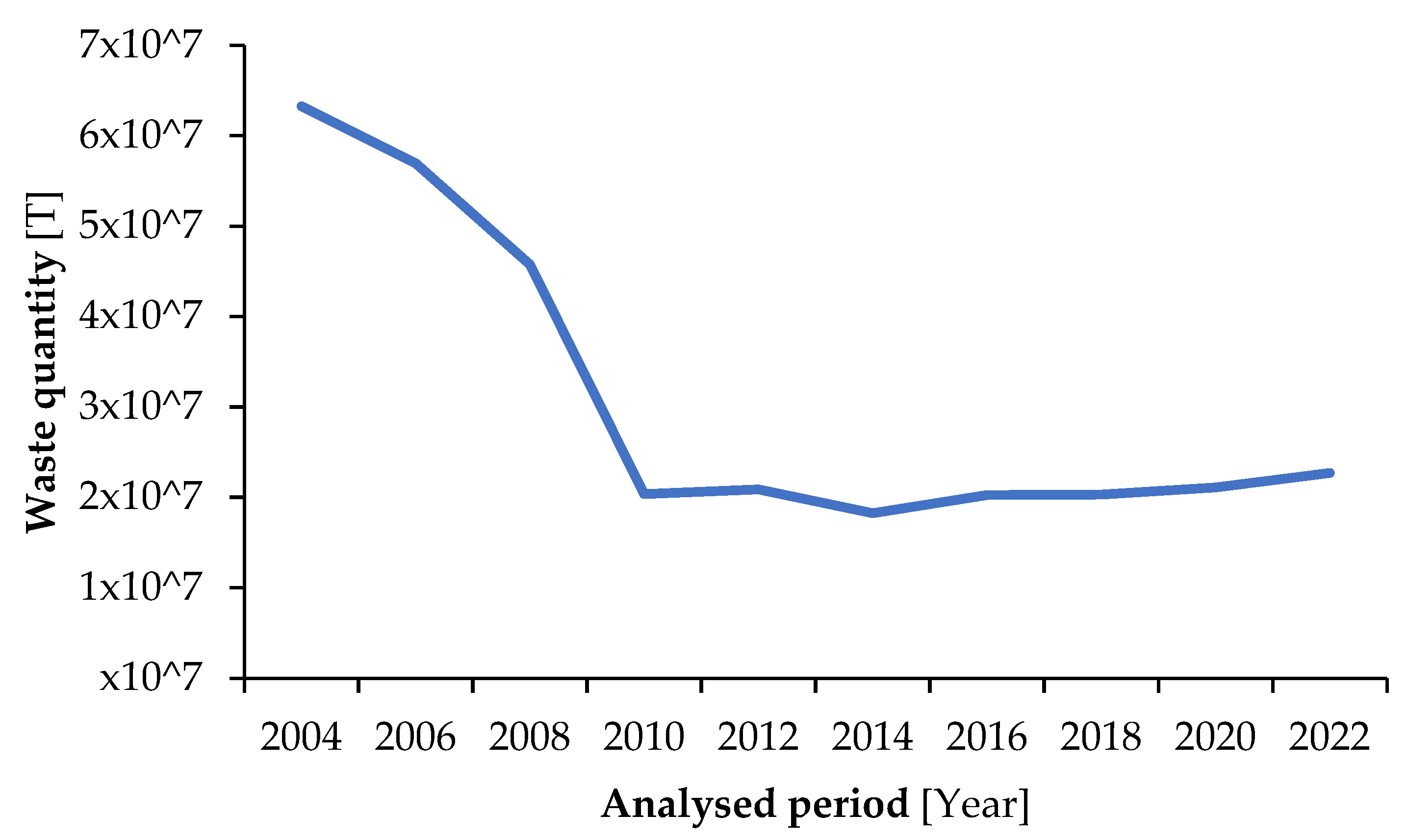
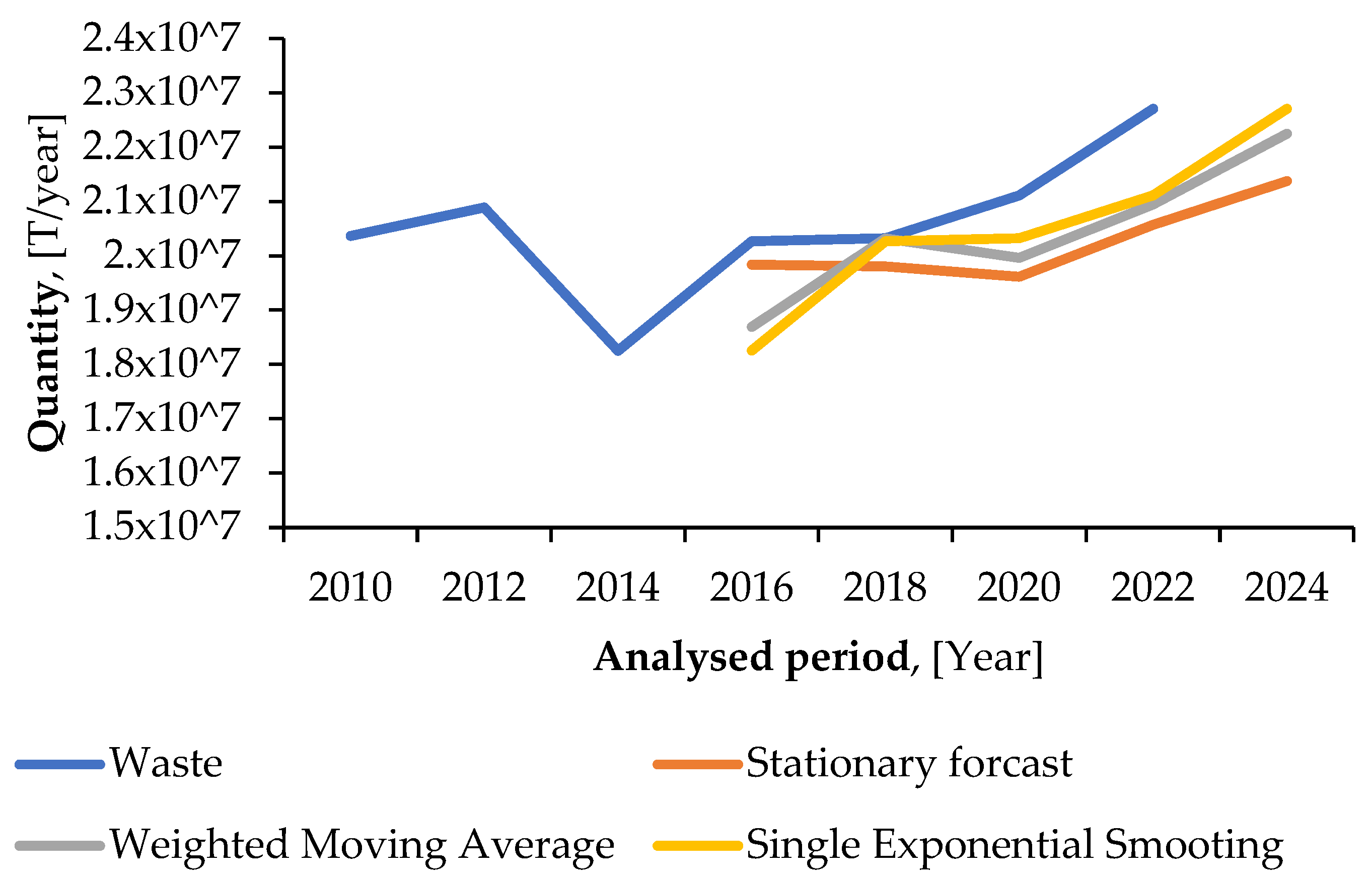
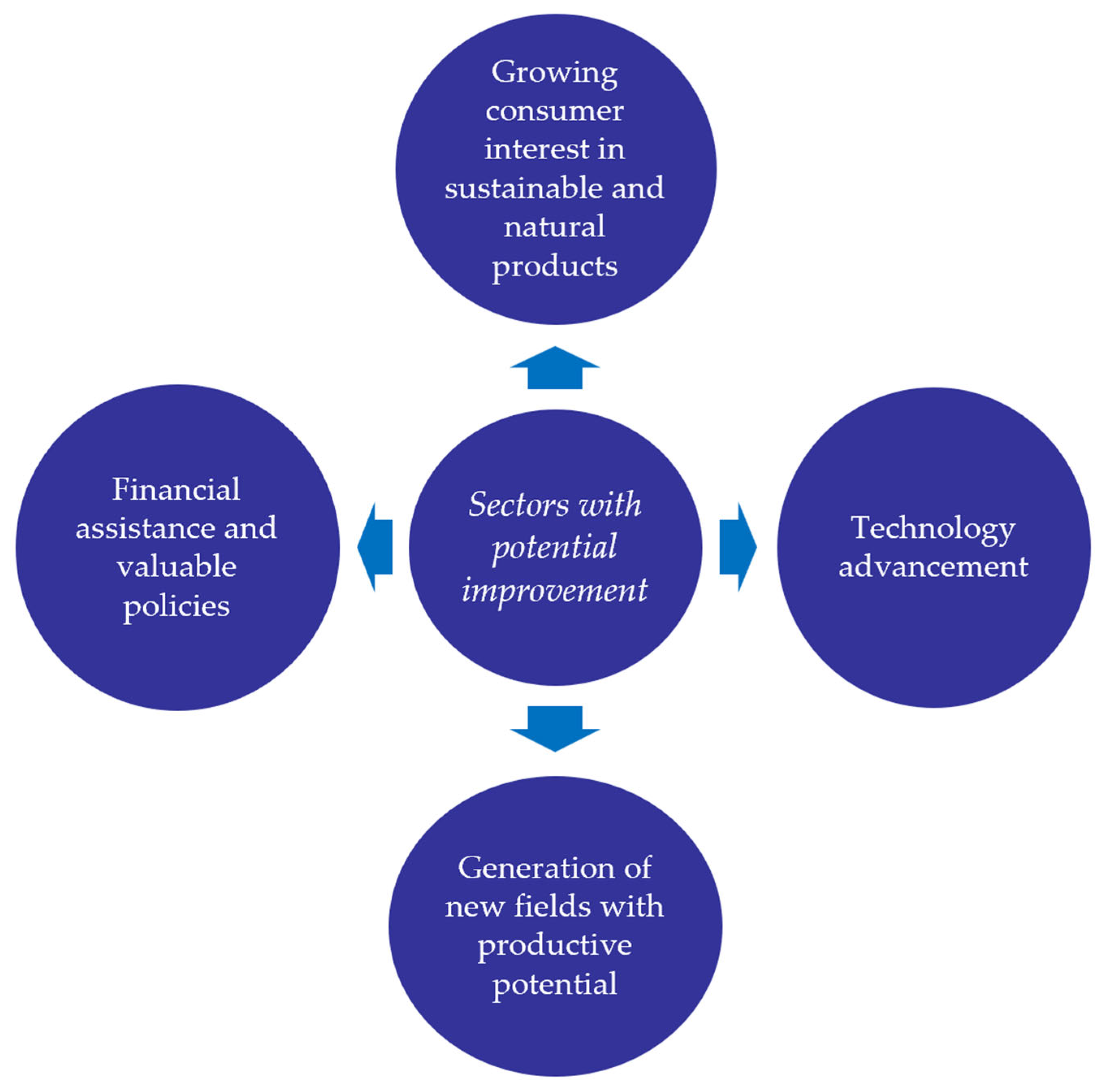

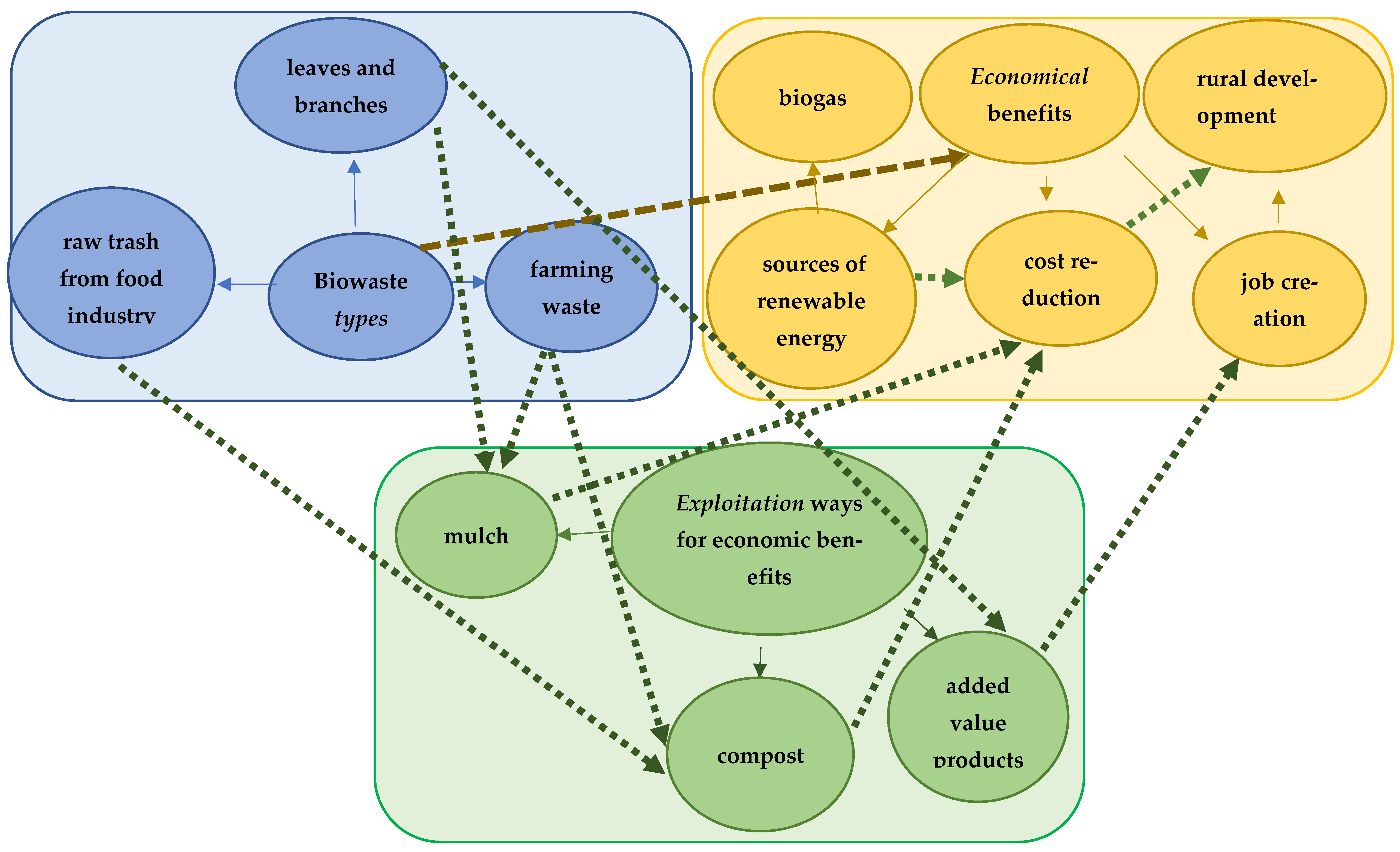
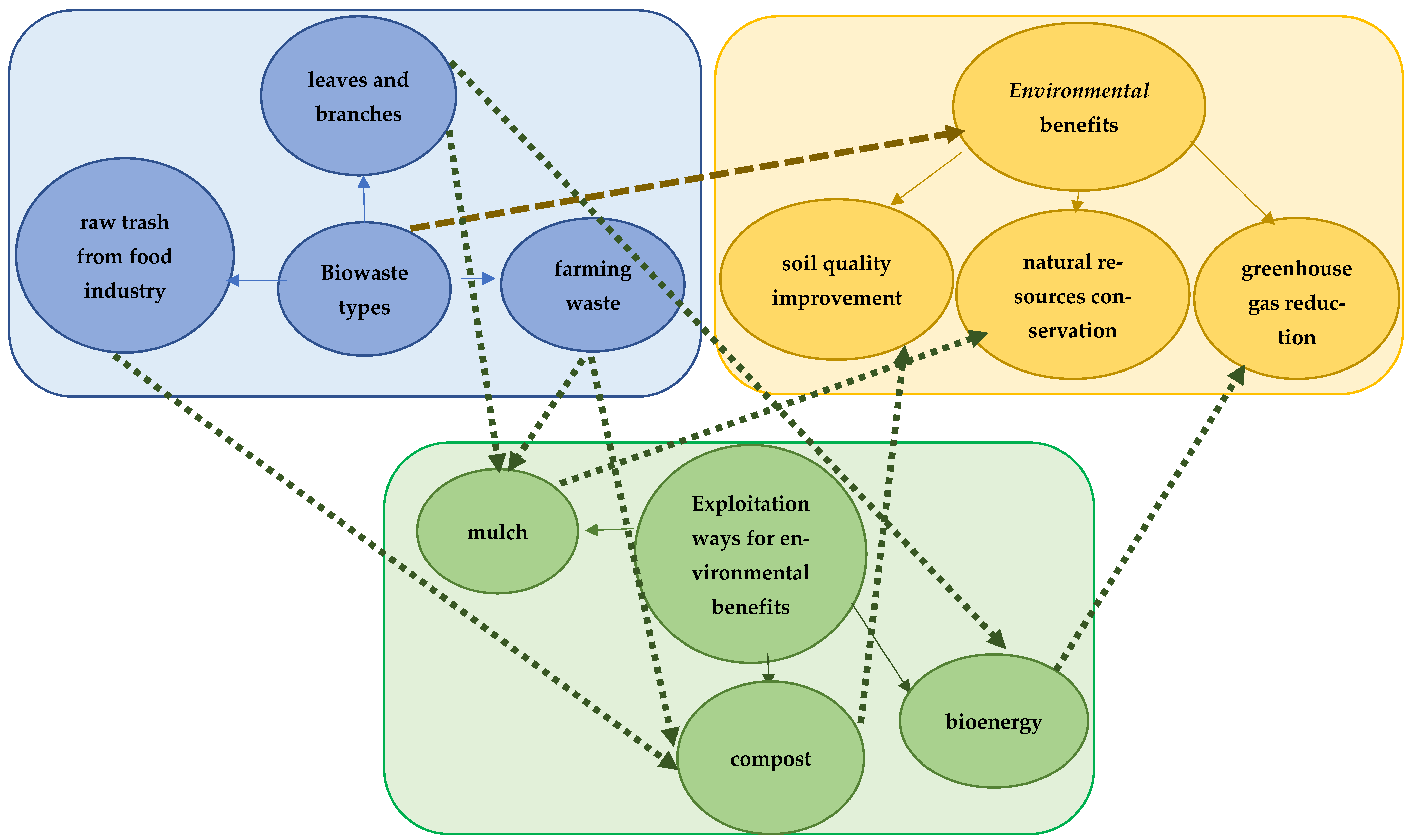

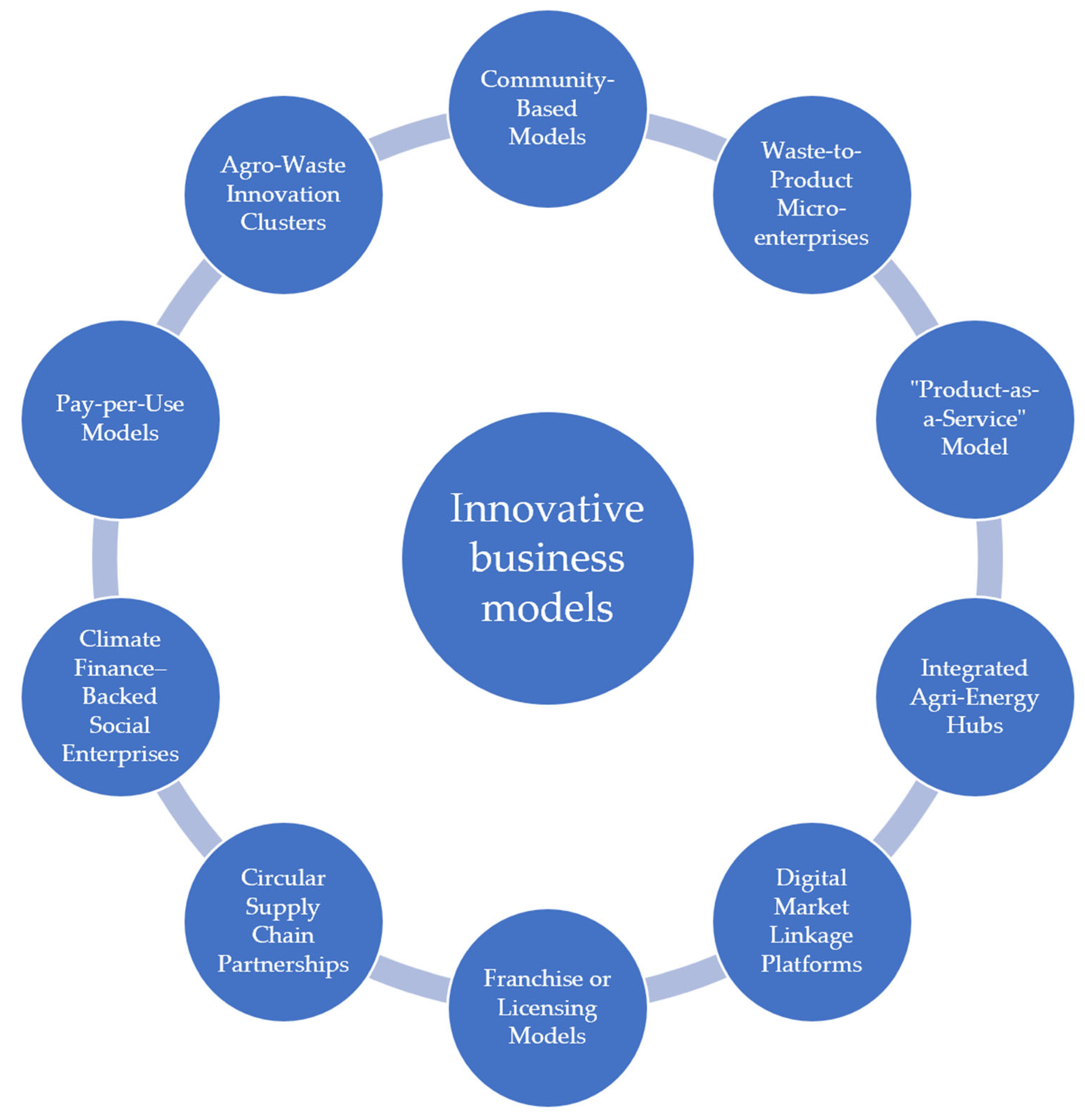
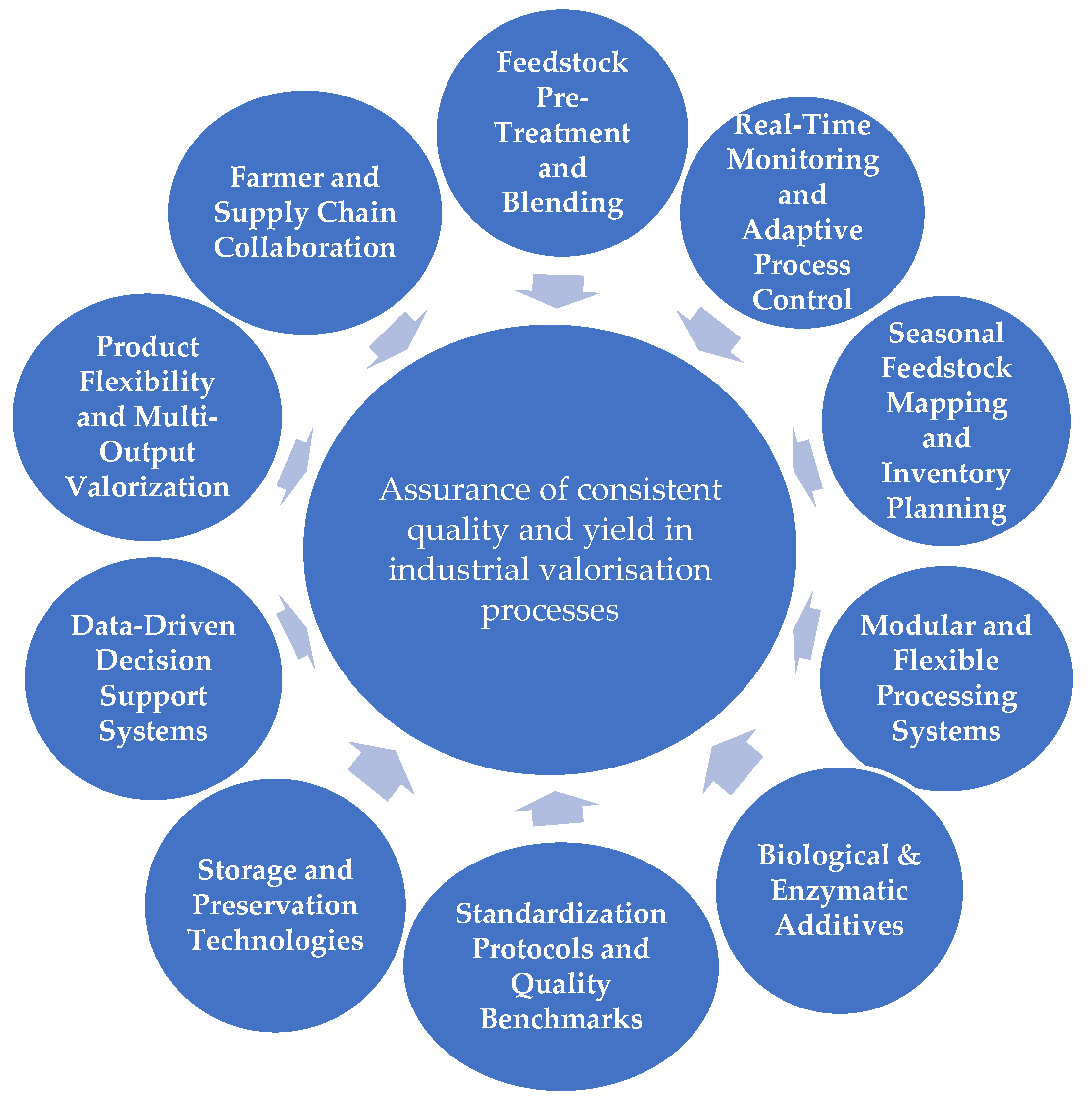

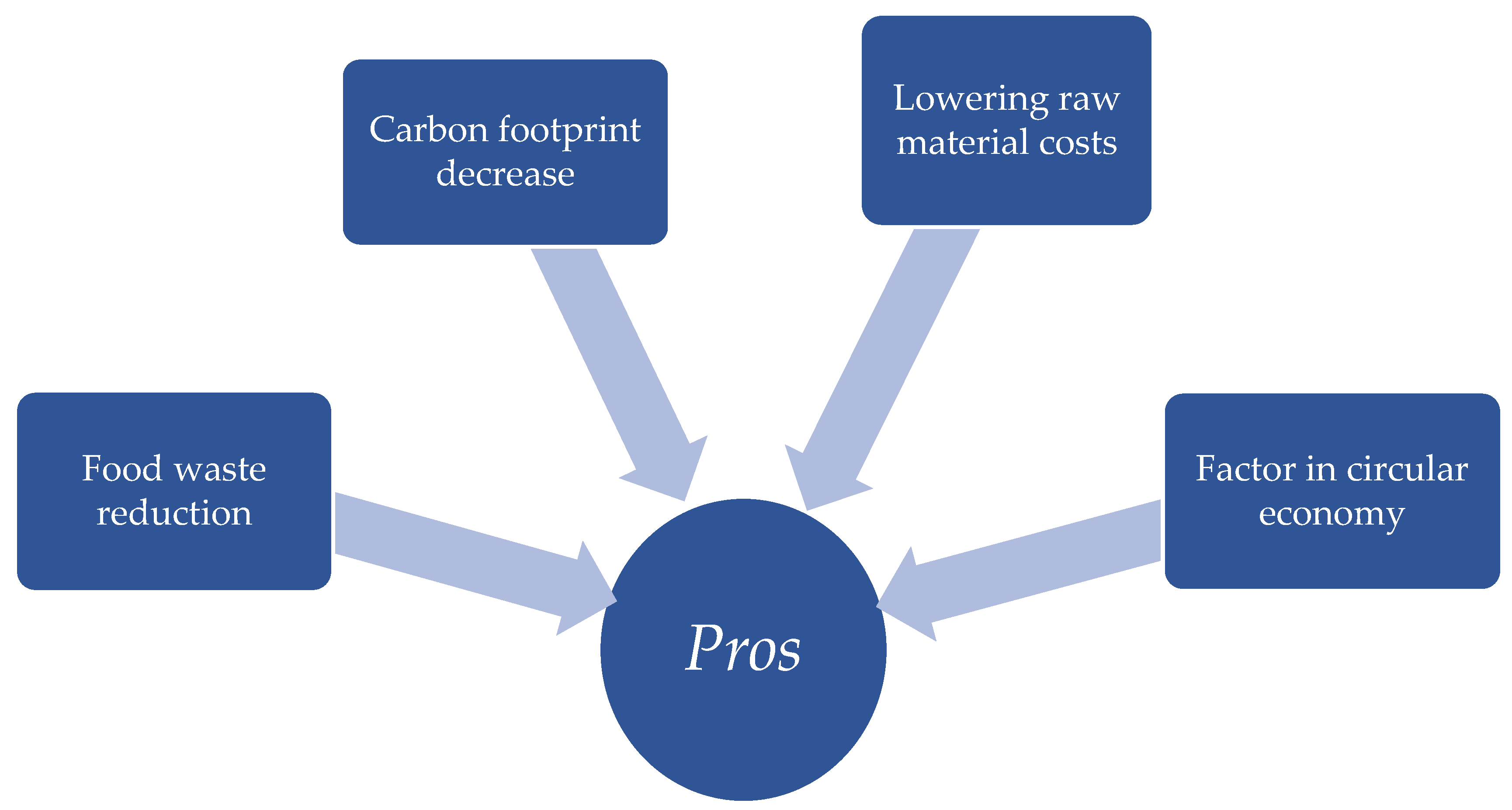
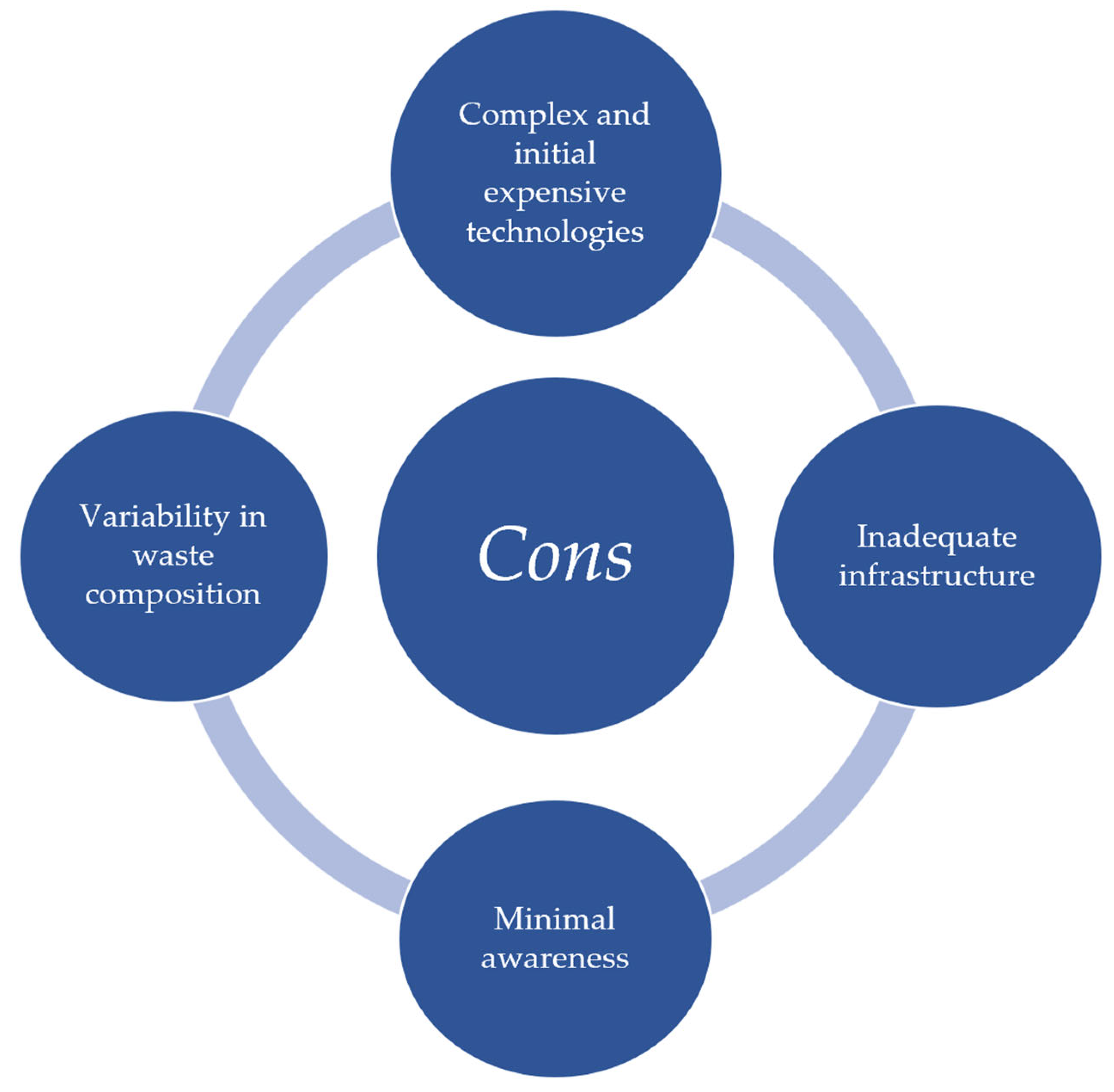
| Type | Crop Waste | Mediator | Reference |
|---|---|---|---|
| Polyhydroxybutyrate (PHB)- bioplastic | Potato peel | Pseudomonas stutzeri PSB1 | [39] |
| Bioplastic composites | Foxtail millet husk (FMH)data | Poly(lactic acid), poly(butylene adipate-co-terephthalate) | [40] |
| Polyhydroxyalkanoates (PHAs) and biosurfactant | Molasses and sweet water from sugar cane and palm oil | Bacteria | [41] |
| Biofilm | Corn starch | Lignocellulose from olive pits powder as padding | [29] |
| Amylose, argan proteins | glycerol | [42] | |
| sugarcane bagasse, and frankincense | Triethyl citrate | [34] | |
| Bioplastic composites | Rice bran | Cellulose, flax, and hazelnut shell as padding | [43] |
| Starch | Holocellulose, xylan, and α-cellulose | [30] | |
| Hydrogel–bioplastic film | Lychee peel extract, banana powder | Iron oxide nanoparticles | [44] |
| Biofertilizer | Wood ash | Digestate stabilizer | [45] |
| Biomaterial Hydroxyapatite | Eggshell | Synthetic urine | [46] |
| Type | Fiber/Additive | Food Model/Activity | Reference |
|---|---|---|---|
| Film | Cellulose nanofiber, Ocimum basilicum L. seed mucilage, Limosilactobacillus fermentum postbiotic | Fish fillet Salmon | [106] |
| Film | Gelatine/zein nanofiber, cinnamaldehyde, thymol | Strawberry Bacteriostatic (Escherichia coli ATCC 25922, Staphylococcus aureus ATCC 6538, Listeria monocytogenes ATCC 19115) | [107] |
| Film | Konjac glucomannan, carboxylated cellulose nanofibers, tannic acid, glycerol | Mango | [108] |
| Membrane | cellulose acetate nanofibers, cinnamon bark, and clove bud oil | Grapes and tomatoes Antioxidant and antimicrobial activity | [109] |
| Film | Anthocyanin, thymol, gelatine, zein | Shrimps Antioxidant and antimicrobial activity (Escherichia coli ATC25922, Listeria monocytogenes ATCC 19115, Staphylococcus aureus ATCC 6538) | [110] |
| Material | Betulin/hydroxypropyl-β-cyclodextrin | Strawberry Antioxidant and antimicrobial activity | [111] |
| Micro-nanofibers | Grapevine extract, gelatine | Cheese Antioxidant and antimicrobial activity | [112] |
| Nanocomposite | Galbanum gum, lignocellulose nanofibers, Satureja khuzestanica essential oils | Shrimps | [113] |
| Composite | Gelatine micro–nano fibres, lemon peel essential oil | Cheese | [114] |
| Film | Cellulose (nanocrystals/nanofibers/carboxymethyl)/sodium alginate/pectin/chitosan, lignosulfonate | Mushrooms Browning limitation | [115] |
| Emulsion | Chitosan, thyme essential oil liposomes encapsulated) | Karish cheese Antimicrobial activities (mesophilic and psychrotrophic bacteria, yeast) | [116] |
| Hydrogel | Chitooligosaccharides, fish skin gelatine nanofiber membranes | Antioxidant and antimicrobial (Escherichia coli) activity | [117] |
| Technology | Stage of Use | Cost-Saving Mechanism | Suitability for Rural Areas | Maturity Level | Reference |
|---|---|---|---|---|---|
| Modular Micro-Scale Biorefineries | Conversion | Low capital cost, local processing reduces transport | ★★★★☆ | Pilot–Commercial | [123,124] |
| Reference Low-Temperature Plasma | Pre-treatment | Reduces chemical and thermal energy use | ★★★☆☆ | Lab–Pilot | [125] |
| Integrated Multi-Product Systems | Conversion/Post-treatment | Extracts multiple products = diversified income | ★★★☆☆ | Early Commercial | [126] |
| AI-Driven Process Optimization | Whole process | Minimizes energy and water use, improves yield | ★★★☆☆ | Early Commercial | [127] |
| Engineered Enzyme Cocktails | Pre-treatment/Conversion | Faster bioconversion, fewer additives needed | ★★★☆☆ | Pilot | [128] |
| Solar Thermal-Assisted Systems | Drying, heating steps | Replaces grid energy with renewable heat | ★★★★★ | Commercial-ready | [129] |
| Bio-based Construction Materials | Post-treatment | Low-tech, labour-intensive = local job creation, low investment | ★★★★★ | Commercial-ready | [130] |
Disclaimer/Publisher’s Note: The statements, opinions and data contained in all publications are solely those of the individual author(s) and contributor(s) and not of MDPI and/or the editor(s). MDPI and/or the editor(s) disclaim responsibility for any injury to people or property resulting from any ideas, methods, instructions or products referred to in the content. |
© 2025 by the authors. Licensee MDPI, Basel, Switzerland. This article is an open access article distributed under the terms and conditions of the Creative Commons Attribution (CC BY) license (https://creativecommons.org/licenses/by/4.0/).
Share and Cite
Gavrilaș, S.; Raț, M.; Munteanu, F.-D. Biowaste Valorisation and Its Possible Perspectives Within Sustainable Food Chain Development. Processes 2025, 13, 2085. https://doi.org/10.3390/pr13072085
Gavrilaș S, Raț M, Munteanu F-D. Biowaste Valorisation and Its Possible Perspectives Within Sustainable Food Chain Development. Processes. 2025; 13(7):2085. https://doi.org/10.3390/pr13072085
Chicago/Turabian StyleGavrilaș, Simona, Mirabela Raț, and Florentina-Daniela Munteanu. 2025. "Biowaste Valorisation and Its Possible Perspectives Within Sustainable Food Chain Development" Processes 13, no. 7: 2085. https://doi.org/10.3390/pr13072085
APA StyleGavrilaș, S., Raț, M., & Munteanu, F.-D. (2025). Biowaste Valorisation and Its Possible Perspectives Within Sustainable Food Chain Development. Processes, 13(7), 2085. https://doi.org/10.3390/pr13072085






